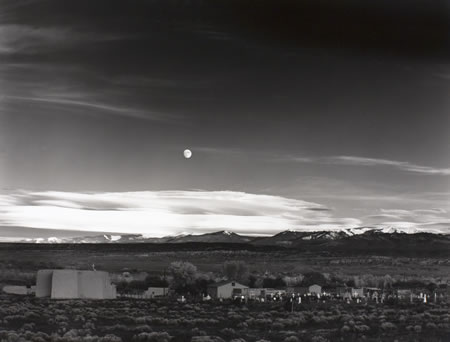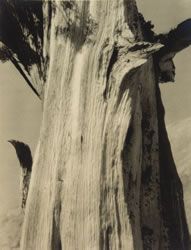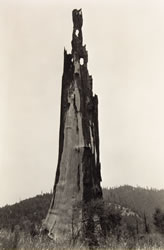"In the pursuit of his private intuition, Adams made landscape photographs that are unlike those of any other photographer. The best of them possess a tenseness -- an edgy, nervous vitality -- that is only barely contained."
--John Szarkowski
"I think of the negative as the ‘score,’ and the print as a ‘performance’ of that score, which conveys the emotional and aesthetic ideas of the photographer at the time of making the exposure." -- Ansel Adams
Andrew Smith Gallery at 122 Grant Ave., Santa Fe, NM 87501, presents the first of a series of not for sale exhibitions of The David H. Arrington Collection of Ansel Adams Photographs. The collection is one of the most comprehensive, stunning group of original Ansel Adams photographs ever assembled. The introductory exhibit of 20 prints opens Friday, May 23 and continues through Sept. 15, 2008.
Ansel Adams is one of the great masters of twentieth century photography, renowned for his magnificent landscapes and exemplary technique. The David H. Arrington Ansel Adams Collection includes some of Adams's earliest photographs; a substantial group of photographs taken in Yosemite Valley, California in the 1920s and 30s; and examples of his most famous photograph, Moonrise, Hernandez, New Mexico, 1941 printed between 1941 and 1975. Additionally, the collection contains the most superlative examples of Adams's vintage masterworks, and showcases hundreds of less well-known images that convey the full scope of Adams's extraordinary vision during his most creative years. Arrington intends to share this collection with the public through a series of exhibitions.
MOONRISE
Moonrise, Hernandez, New Mexico, 1941 is one of the best known photographs of the twentieth century. The photograph was taken thirty miles north of Santa Fe on an late November 1st afternoon as the setting sun illuminated snow capped peaks. In 1948 Adams intensified the lower half of the negative to increase the contrast in the churchyard cemetery.
Adams once said, "Sometimes I do think I get to places just when God is ready to have someone click the shutter!" Here is his account of making Moonrise:
"When I took my moonrise picture, the one with the church and the graveyard at Hernandez, New Mexico, I was driving back to Santa Fe from the Chama Valley and I saw this wonderful scene out of the window. The reaction was so strong I practically drove off the road. I got out the tripod and camera, took the front part of the lens off, screwed it on the back of the shutter and began composing and focusing. All the time I was trying to think of what I'd have to do to make the picture. I couldn't find my exposure meter, but I knew the moon's luminance was 250 candles per square foot and that was placed on Zone VII of the exposure scale. That gave me a shutter speed of a sixtieth of a second at f/8 with a film speed of ASA 64. The filter factor was 3X, so that made the basic exposure a twentieth of a second. I exposed for a long second at f/32, made one picture, and while I was turning the holder around and pulling out the slide to make a duplicate, the sunlight went off the crosses. I got the picture by about 15 seconds!
If I had spent more time in the Chama Valley, I would have missed the entire thing. If I had come home earlier, I would have missed it. So there's always an element of chance in photography. If you have practiced and practiced, the process is intuitive. You suddenly recognize something, and you react."
Moonrise, Hernandez, New Mexico, 1941
Negative Date: 1941
Print Date: 1941
9.25" x 12" Vintage Silver Gelatin Print
In this vintage print made in 1941, Adams printed a straightforward landscape of a New Mexican church, cemetery and snowcapped peaks below a light, cloud filled sky. The print is a slight enlargement of the 8x10" negative. The details in the land and sky are crisp and the ground appears slightly darker than the sky. Printed in mid-gray tones, the photograph has great delicacy and softness. Clouds, clearly visible throughout the sky, will become less visible in later prints. Probably fewer than 10 Moonrises were made prior to 1948, making these prints extremely rare.
|
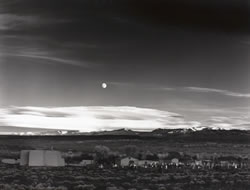 |
Moonrise, Hernandez, New Mexico, 1941
Negative Date: 1941
Print Date: March 1943
16" x 20" Vintage Silver Gelatin Print
The second print on display was made by Adams in 1943. It was his favorite and hung in his Yosemite home for decades. Adams printed this photograph on a much warmer paper than the print made in 1941. Overall, the photograph is darker, the values in the ground and sky having deepened and intensified. Most significantly, the sky has now become a "twilight" sky, with fewer high level clouds visible.
|
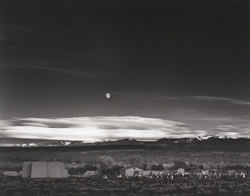 |
Moonrise, Hernandez, New Mexico, 1941
Negative Date: 1941
Print Date: 1962 ca.
21" x 26.7" Silver Gelatin Print
Made in 1962 ca., this mural size exhibition print shares many of the classic characteristics of the early prints, the lighter sky burned in to appear darker, and printed on a high contrast paper. In this elegant print the clouds and the snowy peaks are whiter with black textures against a "evening" sky. There is more definition within the thick layer of clouds and the crosses in the cemetery are brilliant pinpoints of light.
|
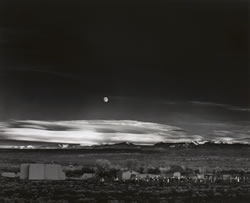 |
Moonrise, Hernandez, New Mexico, 1941
Negative Date: 1941
Print Date: 1975 ca.
15.5" x 19.3" Silver Gelatin Print
In this late print Adams printed the sky nearly midnight black and brightened the clouds and churchyard crosses to create an elemental, emotional statement about beauty and mortality. Thus, Adams completed the printing cycle of "Moonrise" over the course of his lifetime, turning the print from an afternoon picture to a dramatic "night" view. |
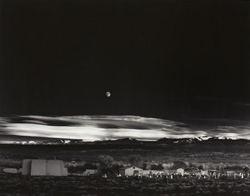 |
In his book Examples: The Making of 40 Photographs, Adams wrote:
"This photograph has undoubtedly evoked more comment than any other I have made and represents an unusual situation of content and effect. I am sure that the image would command a general interest for the subject alone. It is a romantic/emotional moment in time. I think it would have a certain appreciation even if poorly printed However, the mood of the scene requires subtle value qualities in the print that I feel are supportive of the original visualization. The printed image has varied over the years; I have sought more intensity of light and richness of values as time goes on."
MODERNISM AND YOSEMITE
In 1933 Adams visited Alfred Stieglitz in New York City and showed him a number of his small contact prints that he felt represented his best work. Stieglitz, a great proponent of modernism, liked the photos, describing them as "straight" and seen with "sensitivity." Adams returned annually to show Stieglitz his work and in 1936 he had his first exhibition at An American Place. The following photographs represent Adams's early work and its modernist concerns.
Light Hitting Juniper Tree
Negative Date: 1928
Print Date: 1928 ca.
Silver Gelatin Print
In his stately, often minimal landscapes from the late 1920s, Adams was searching for abstract arrangements of line, mass, and tonal contrasts that serve to express the artist's personal feelings about his subjects. The striated trunk of an old growth juniper tree fills this photograph in much the same way as Edward Weston's "Pepper" dominates its picture plane. Adams minimized other information in the background. A distant mountain is scarcely visible behind the tree, and foliage is merely alluded to as a cast shadow on the tree trunk. For all its strength of composition the image, printed on delicate Parmelian paper, has a surprisingly soft tactility.
|
|
From Wawona Tunnel, Winter, Yosemite
Negative Date: 1930s ca
Print Date: 1930 ca.
Silver Gelatin Print
Well aware that the glorious vista of Yosemite Valley is revealed as one emerges from Wawona Tunnel, Adams used the black, arching roof of the tunnel studded with icicles to frame the sunny vista of snow covered mountains. Tire tracks in the deep snow lead the eye into the distance. Adams used a full range of tones to make this photograph, from the jet black stone wall of the tunnel to the dazzling, sun lit snow. This photograph is descriptive of the spectacular but harsh terrain that Adams drove through to make his winter photographs.
|
 |
Snow Fall
Negative Date: 1930 ca.
Print Date: 1930 ca.
Silver Gelatin Print
This lovely photograph printed on thin tissue departs from Adams's crisp and minimal vision and embraces his mastery of the pictorial subject and processes which he favored in the 1910s and 1920s. It is a soft focus scene of cottonwoods, pine trees and river willows covered with snow. A car's tire tracks lead the eye back into this dreamlike scene. Adams printed the photograph in soft middle tones, avoiding either strong whites or blacks. The frothy trees circle protectively around the center of the picture plane, inviting the viewer to wander through this enchanted landscape. The photograph is signed 'Ansel E. Adams' and annotated, 'Fiske.' The annotation may refer to the tree named after George Fiske, an earlier photographer of Yosemite. |
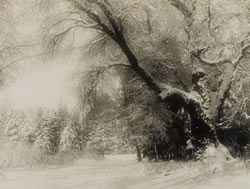 |
FROM THE 100 YEAR SHOW
In commemoration of the 100th anniversary of Ansel Adams's' birth the eminent photography critic John Szarkowski, director emeritus of the Department of Photography at New York's Museum of Modern Art, culled from a lifetime of work the finest examples of Adams's photographic prints. Some of these exhibition prints were later acquired by David H. Arrington and are on display at Andrew Smith Gallery.
Merced Peak From Red Peak
Negative Date: 1920
Print Date: 1920 ca.
Silver Gelatin Print
In this tiny print (only 3" x 4") Adams succeeds in describing the dramatic immensity of snow covered mountain ridges rising one after the other like ocean waves. Taken when Adams was 18 it demonstrates a mature sense of art and composition. The featureless white snow acts as negative shapes against the dark rock in this small masterpiece of abstraction. In his autobiography Adams wrote:
"At dawn I crept from my bag into the cold Sierra air at seventy-five hundred feet elevation. A broad spur of granite touched the river nearby, and I decided to climb it, beckoned by the sunrise light on the sparse and rugged trees more than a thousand feet above me. As I ascended, the vistas of the Merced Canyon opened and I soon saw the crags below Mount Clark shining in the early light, their spires dominating all I could see."
|
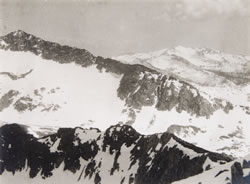 |
Glacier Polish, Lyell Fork of Merced River, Yosemite National Park
Negative Date: 1938
Silver Gelatin Print
The subject of this photograph are horizontal slabs of smooth rock lying on the ground. Deep fractures in the stone draw the eye toward a mountain ridge in the distance. Reflecting sunlight, the bright surface of the rock is only slightly lighter than the cloudless sky overhead. According to Adams:
"As with all art, the photographer's objective is not the duplication of visual reality. Photographic images cannot avoid being accurate optically, as lenses are used. However, they depart form reality in direct relation to the placement of the camera before the subject, the lens chosen, the film and filters, the exposure indicated, the related development and printing; all, of course, relating to what the photographer visualizes." Ansel Adams: An Autobiography p. 79
|
 |
Snag Near Scotia, CA
Negative Date: no date
Print Date: no date
Silver Gelatin Print
In this sparse composition Adams photographed the remains of a charred tree trunk rising to a point like a Gothic cathedral spire. Forested hills occupy the lower portion of the picture plane, but otherwise the background is a neutral sky. At the base of the dead tree a tiny tree flourishes in the thick grasses. |
|
CLASSIC WORKS
Mount Williamson, The Sierra Nevada, from Manzanar, California
Negative Date: 1944
Print Date: 1952 ca.
Silver Gelatin Print
Adams's sublime photograph of Mount Williamson transcends and is underscored by the circumstances during which it was made. Adams was so distressed by the internment of Japanese-Americans that occurred after Pearl Harbor was bombed that he requested and was given permission to photograph them at the Manzanar War Relocation Center in the Owens Valley at the foot of Mount Williamson. Although he believed photography should convey a positive message, at the same time he was incensed at the incarceration of innocent Japanese American families. On that trip he photographed the harsh beauty of Mt. Williamson, capturing a relentless valley of rocks below its cloud swept peaks. In his book, Ansel Adams: Examples, The Making of 40 Photographs, he suggested the harsh land may have been emotionally sustaining to the uprooted citizens.
"I have believed that the setting of this camp, no matter how desolate the immediate desert surround, was a strengthening inspiration to the people. The enormous backdrop of the Sierra Nevada to the west and the high desert ranges to the east gave the nature-loving Japanese-Americans a certain respite from their mood of isolation and concern for the future. "
|
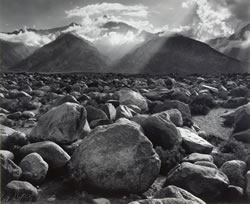 |
Rose and Driftwood, San Francisco
Negative Date: 1932
Print Date: 1962 ca.
7.6 x 9.5” Silver Gelatin Print
One day in 1932 Adams's mother brought him a large, pale pink rose from her garden. Adams immediately decided to photograph it and placed it in front of his north facing window where its petals appeared translucent in the light. Then he began searching for the perfect background. He tried a number of things -- bowls, pillows and stacked books but was unhappy with the effects. Finally he remembered a piece of weather plywood he had picked up on a nearby beach and set the rose on top of it under a window. He knew immediately that the shape of the petals related perfectly to the textured plywood, and he proceeded to take the photograph using a 4 x 5-inch view camera with an 8-inch Zeiss Kodak Anastigmat lens. "Rose and Driftwood" is not only a striking modernist image, but reveals Adams's innovation in finding art making possibilities in the rarely explored world of the "small and commonplace."
At the time Adams made the photograph it was widely believed that every photograph should relate to some example in another art form. He later wrote of this image,
"I seldom, if ever, thought that a photograph might be influenced by another photograph. Of course I had seen flower paintings, but never, as I recall, one of a single large flower. I had certainly not seen any of Georgia O'Keeffe's marvelous large paintings of flower forms. In retrospect I believe that this picture was an isolated inspiration, free of any association in art that I knew about. It was simply a beautiful object with a sympathetic background and agreeable light."
|
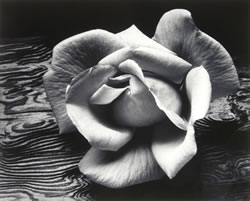 |
The Golden Gate Before the Bridge, San Francisco, California
Negative Date: 1932 ca.
Print Date: no date
6" x 9" Silver Gelatin Print
Having recently acquired his first 8 x 10-inch view camera, Adams was inspired one "beautiful storm-clearing morning" in 1932, to photograph the grand view of the Golden Gate from the crest of a promontory. The clouds were moving fast, mists swirled and a stiff wind vibrated the camera. Adams managed to make a sharp negative of the sweeping bay, rolling headlands and billowing white clouds. His composition was based on the staggered horizontal planes of land, sea and sky, printed in various tonalities to create a satisfying abstract quality. The Golden Gate Before the Bridge soon became one of Adams's most popular images, coupling a modernist vision of a spectacular landscape with a historic record of the bay before construction of the Golden Gate Bridge began in 1933. The staggered horizontal compositions became a trademark of many of Adam's' most memorable photographs.
Ansel Adams was well aware of the wide range of effects he could achieve by printing the same image in different sizes. He made this exquisite vintage contact print shortly after the negative was made. It is remarkable for its deep, rich density, not unlike prints made by Edward Weston from this same period who also printed on a pre-World War II papers that had an especially high silver content. In this size the print is more about the essentials of photographic printing than conveying the literal and historical information displayed in the larger print of the same image.
|
 |
Canyon De Chelly National Monument, Arizona
Negative Date: 1947 ca.
Print Date: 1952 ca.
15" x 18.875" Silver Gelatin Print
Adams printed these two photographs of Canyon De Chelly within five years of each other in different sizes and on different papers. The larger print has a slightly warmer tone leaning toward purplish-black. It fully conveys the dramatic monumentality of Canyon De Chelly that Adams wrote about:
"The Canyon de Chelly is geologically impressive. Its stone is largely solidified sand dunes, which accounts for the beautiful, flowing patterns revealed on the eroded cliffs. The floor of the canyon is almost entirely a sandy riverbed that in times of rain becomes of quicksand instability. In autumn, the cottonwoods take on a vibrant hue that blends with the warm colors of the cliffs. Some of my best photographs have been made in and on the rim of the canyon." Ansel Adams: An Autobiography.
|
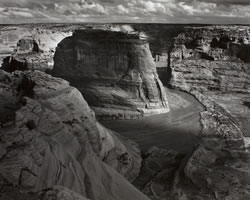 |
Canyon De Chelly National Monument, Arizona
Negative Date: 1947 ca.
Print Date: no date
7.5" x 9.5" Silver Gelatin Print
In the small print of Canyon de Chelly Adams created a magnificent image using a wide range of tonal values in even minute details. The tone of this print is bluer and cooler than the larger print. Though different, each of these prints are perfect in their own ways.
|
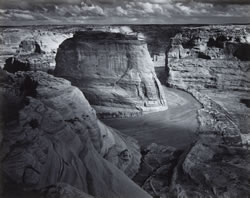 |
Aspens, Northern New Mexico [horizontal]
Negative Date: 1958
Print Date: 1963 ca.
16" x 20" Silver Gelatin Print
This Adams' masterpieces was taken in 1958 of a stand of young aspen trees in the Sangre de Cristo mountains above Santa Fe. The effervescent image made with an 8x10" camera gives little clue to the complex stratagem used by Adams to achieve it. According to Adams, "The majority of viewers of the horizontal image think it was a sunlit scene." In fact, it was taken in the shadow of the mountains, where the light was cool and quiet and no wind was stirring. Using filters to shoot the photograph, and then following the rules of his Zone System in the darkroom, Adams strove to make a photograph that was neither "too dark," nor "too light." Adams was with two other photographers when he made his negatives. As they set up their cameras they found both Eliot Porter and Laura Gilpin photographing in the same grove.
|
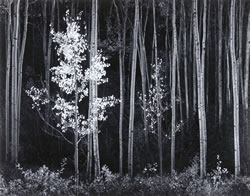 |
Clearing Winter Storm, Yosemite National Park, CA
Negative Date: 1938
Print Date: 1960 ca.
24 x 31" Silver Gelatin Print
In his autobiography, Adams recounts that when he was thirteen he and his parents traveled for the first time from San Francisco to Yosemite where the boy instantly fell in love with the magnificent park. Shortly after their arrival his parents gave him his first camera, a Kodak Box Brownie. He was in the process of taking his first photograph of Half Dome when the old stump he had climbed on to get a good view crumbled out from underneath him and he fell headfirst to the ground. At the same moment he accidentally pushed the shutter. The local photographer who developed the roll of film questioned the boy how it was that the first negative, a reasonably clear photograph of Half Dome and Clouds, appeared upside down.
In 1937 Adams and his wife moved to Yosemite where Adams took over management of the studio founded by his wife's father, the artist Harry C. Best. During the nearly ten years they lived there spectacular weather events were frequent. Because he was photographing with cumbersome 8x10 and 4x5 inch view cameras Adams had to time his photo sessions carefully.
Clearing Winter Storm was photographed in early December from New Inspiration Point. Adams wrote of it: "Although the scene was of low general contrast, my visualization of the final print was quite vigorous. The subject had a very dramatic potential." He used a 12 1/4-inch Cooke lens and a fairly short exposure time to avoid showing movement in the clouds. After focusing he wiped a few drops of rain off the lens and kept it covered with a lens cap until the moment of exposure.
Not one for retouching negatives, Adams did a certain amount of burning and dodging in the darkroom to achieve the tonal balance demanded by his visualization. What he wrote about this photograph applies to all his masterworks: "I think of the negative as the ‘score,’ and the print as a ‘performance’ of that score, which conveys the emotional and aesthetic ideas of the photographer at the time of making the exposure."
Many consider this picture to be the last great photograph made in the classically pictorial style of 19th century and early 20th century painting and photography.
|
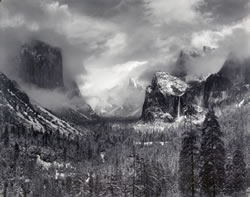 |
Autumn Storm, Las Trampas, Near Peñasco, NM
Negative Date: 1958
Print Date: 1963 ca.
10.25 x 12.75" Silver Gelatin Print
In this exquisite study of an afternoon storm in northern New Mexico, Adams photographed a secluded mountain valley streaked with light and shadow. As layers of gray and white clouds scuttled overhead and wind shook cottonwood trees, Adams caught the roof and tower of a country church momentarily struck by sunlight. The black and white photograph is as evocative of a time and place as an Impressionist painting.
|
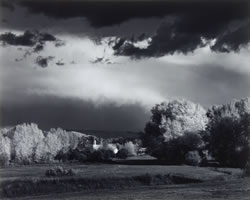 |
Aspens, Dawn, Dolores River Canyon, Colorado
Negative Date: 1937
Print Date: 1981
9.25 x 13.625" Silver Gelatin Print
As if lit from within, leafless aspen trees create a lacy horizontal pattern against a dark picture plane. The detail of bark, branches, twigs, and shrubs below is extremely crisp. This photograph was made in 1937 on a trip through New Mexico, Arizona and Colorado that Adams made with Dave McAlpin, Georgia O'Keeffe and a guide named Orville Cox. |
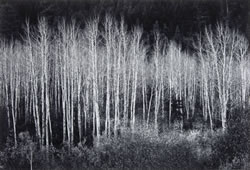 |
Liz Kay |
